The Impact of Cultural Elements on Global Marketing Strategies
VerifiedAdded on 2020/03/28
|9
|1904
|137
AI Summary
The report examines how culture profoundly affects global marketing by influencing consumer behavior, service quality perceptions, and marketing strategies. It highlights key cultural dimensions such as individualism versus collectivism, power distance, masculinity versus femininity, and uncertainty avoidance, explaining their impact on marketing practices across different regions. By referencing various academic studies, the report underscores the necessity for multinational corporations to adapt their marketing strategies to align with local cultural contexts to achieve successful international business outcomes. It concludes that understanding and integrating cultural nuances are crucial for effective global marketing execution.

RUNNING HEAD: International Marketing
1
International Marketing
1
International Marketing
Paraphrase This Document
Need a fresh take? Get an instant paraphrase of this document with our AI Paraphraser
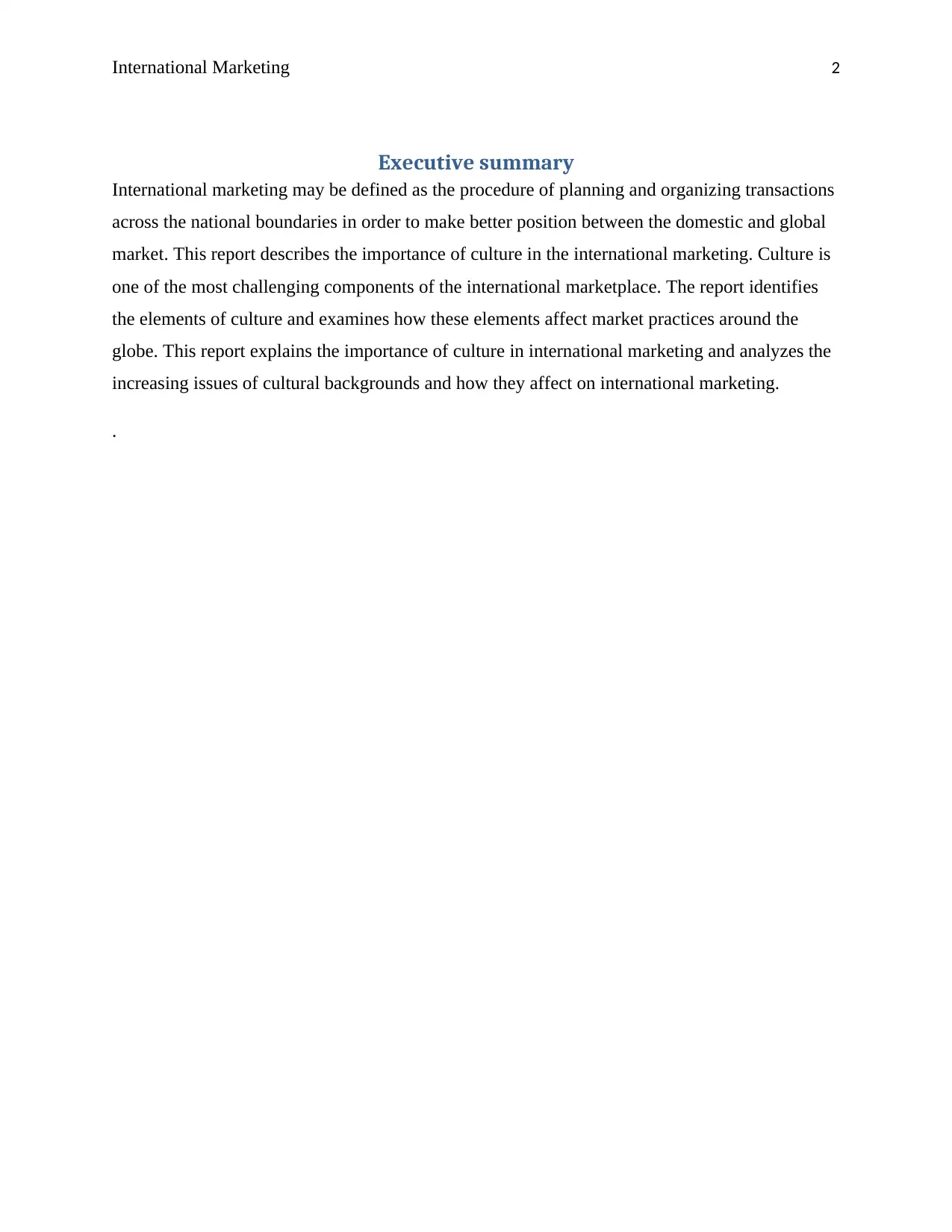
International Marketing 2
Executive summary
International marketing may be defined as the procedure of planning and organizing transactions
across the national boundaries in order to make better position between the domestic and global
market. This report describes the importance of culture in the international marketing. Culture is
one of the most challenging components of the international marketplace. The report identifies
the elements of culture and examines how these elements affect market practices around the
globe. This report explains the importance of culture in international marketing and analyzes the
increasing issues of cultural backgrounds and how they affect on international marketing.
.
Executive summary
International marketing may be defined as the procedure of planning and organizing transactions
across the national boundaries in order to make better position between the domestic and global
market. This report describes the importance of culture in the international marketing. Culture is
one of the most challenging components of the international marketplace. The report identifies
the elements of culture and examines how these elements affect market practices around the
globe. This report explains the importance of culture in international marketing and analyzes the
increasing issues of cultural backgrounds and how they affect on international marketing.
.

International Marketing 3
Table of Contents
Introduction......................................................................................................................................4
Cultural factor which influences on International Marketing..........................................................4
Language......................................................................................................................................4
Religion........................................................................................................................................4
Social organizations.....................................................................................................................5
Attitudes and values.....................................................................................................................5
Aesthetics.....................................................................................................................................5
STEEP Analysis...............................................................................................................................5
Social............................................................................................................................................5
Technological...............................................................................................................................5
Economical...................................................................................................................................6
Environmental..............................................................................................................................6
Political........................................................................................................................................6
Significance of culture in International marketing..........................................................................6
Power Distance............................................................................................................................6
Individualism...............................................................................................................................7
Uncertainty Avoidance................................................................................................................7
Conclusion.......................................................................................................................................8
References........................................................................................................................................9
Table of Contents
Introduction......................................................................................................................................4
Cultural factor which influences on International Marketing..........................................................4
Language......................................................................................................................................4
Religion........................................................................................................................................4
Social organizations.....................................................................................................................5
Attitudes and values.....................................................................................................................5
Aesthetics.....................................................................................................................................5
STEEP Analysis...............................................................................................................................5
Social............................................................................................................................................5
Technological...............................................................................................................................5
Economical...................................................................................................................................6
Environmental..............................................................................................................................6
Political........................................................................................................................................6
Significance of culture in International marketing..........................................................................6
Power Distance............................................................................................................................6
Individualism...............................................................................................................................7
Uncertainty Avoidance................................................................................................................7
Conclusion.......................................................................................................................................8
References........................................................................................................................................9
⊘ This is a preview!⊘
Do you want full access?
Subscribe today to unlock all pages.

Trusted by 1+ million students worldwide
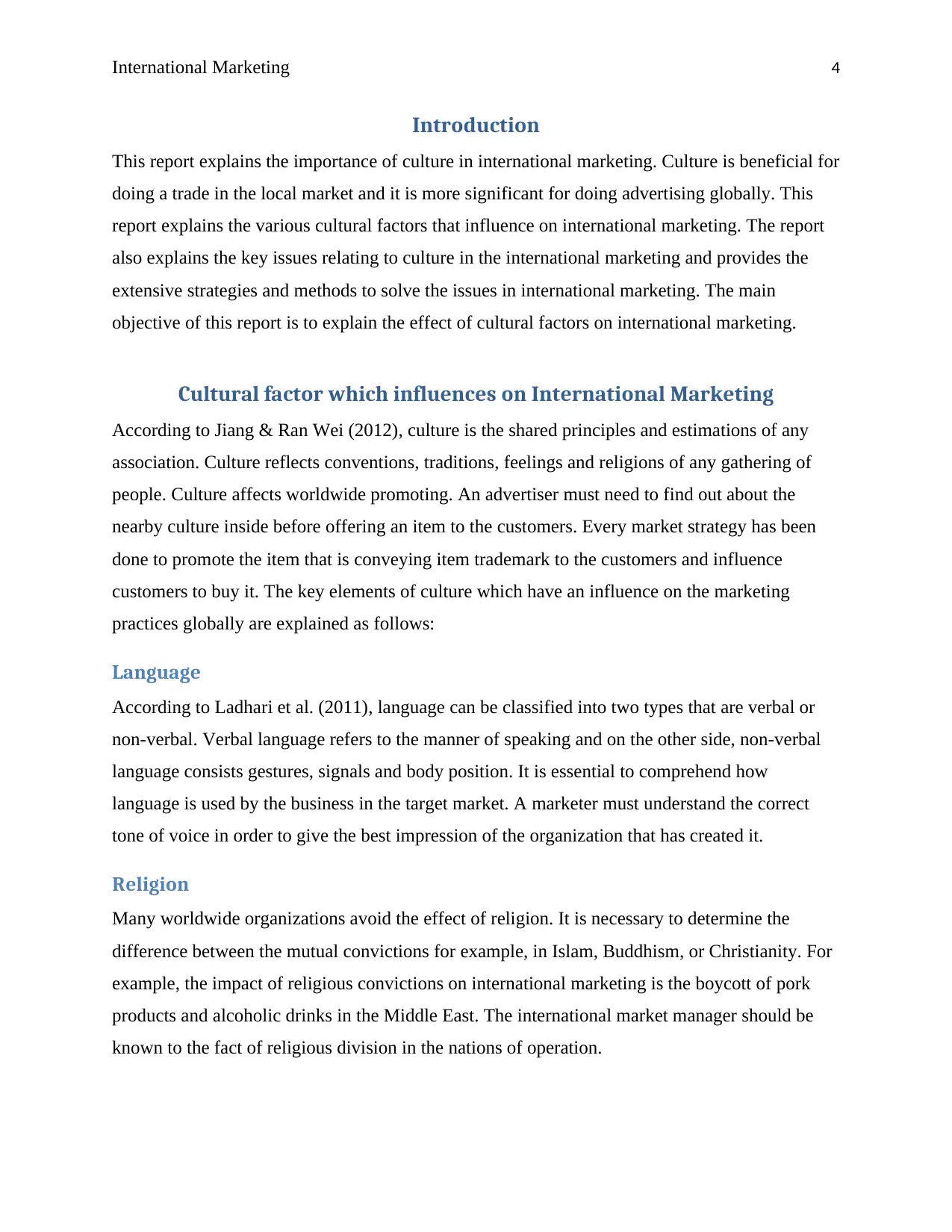
International Marketing 4
Introduction
This report explains the importance of culture in international marketing. Culture is beneficial for
doing a trade in the local market and it is more significant for doing advertising globally. This
report explains the various cultural factors that influence on international marketing. The report
also explains the key issues relating to culture in the international marketing and provides the
extensive strategies and methods to solve the issues in international marketing. The main
objective of this report is to explain the effect of cultural factors on international marketing.
Cultural factor which influences on International Marketing
According to Jiang & Ran Wei (2012), culture is the shared principles and estimations of any
association. Culture reflects conventions, traditions, feelings and religions of any gathering of
people. Culture affects worldwide promoting. An advertiser must need to find out about the
nearby culture inside before offering an item to the customers. Every market strategy has been
done to promote the item that is conveying item trademark to the customers and influence
customers to buy it. The key elements of culture which have an influence on the marketing
practices globally are explained as follows:
Language
According to Ladhari et al. (2011), language can be classified into two types that are verbal or
non-verbal. Verbal language refers to the manner of speaking and on the other side, non-verbal
language consists gestures, signals and body position. It is essential to comprehend how
language is used by the business in the target market. A marketer must understand the correct
tone of voice in order to give the best impression of the organization that has created it.
Religion
Many worldwide organizations avoid the effect of religion. It is necessary to determine the
difference between the mutual convictions for example, in Islam, Buddhism, or Christianity. For
example, the impact of religious convictions on international marketing is the boycott of pork
products and alcoholic drinks in the Middle East. The international market manager should be
known to the fact of religious division in the nations of operation.
Introduction
This report explains the importance of culture in international marketing. Culture is beneficial for
doing a trade in the local market and it is more significant for doing advertising globally. This
report explains the various cultural factors that influence on international marketing. The report
also explains the key issues relating to culture in the international marketing and provides the
extensive strategies and methods to solve the issues in international marketing. The main
objective of this report is to explain the effect of cultural factors on international marketing.
Cultural factor which influences on International Marketing
According to Jiang & Ran Wei (2012), culture is the shared principles and estimations of any
association. Culture reflects conventions, traditions, feelings and religions of any gathering of
people. Culture affects worldwide promoting. An advertiser must need to find out about the
nearby culture inside before offering an item to the customers. Every market strategy has been
done to promote the item that is conveying item trademark to the customers and influence
customers to buy it. The key elements of culture which have an influence on the marketing
practices globally are explained as follows:
Language
According to Ladhari et al. (2011), language can be classified into two types that are verbal or
non-verbal. Verbal language refers to the manner of speaking and on the other side, non-verbal
language consists gestures, signals and body position. It is essential to comprehend how
language is used by the business in the target market. A marketer must understand the correct
tone of voice in order to give the best impression of the organization that has created it.
Religion
Many worldwide organizations avoid the effect of religion. It is necessary to determine the
difference between the mutual convictions for example, in Islam, Buddhism, or Christianity. For
example, the impact of religious convictions on international marketing is the boycott of pork
products and alcoholic drinks in the Middle East. The international market manager should be
known to the fact of religious division in the nations of operation.
Paraphrase This Document
Need a fresh take? Get an instant paraphrase of this document with our AI Paraphraser
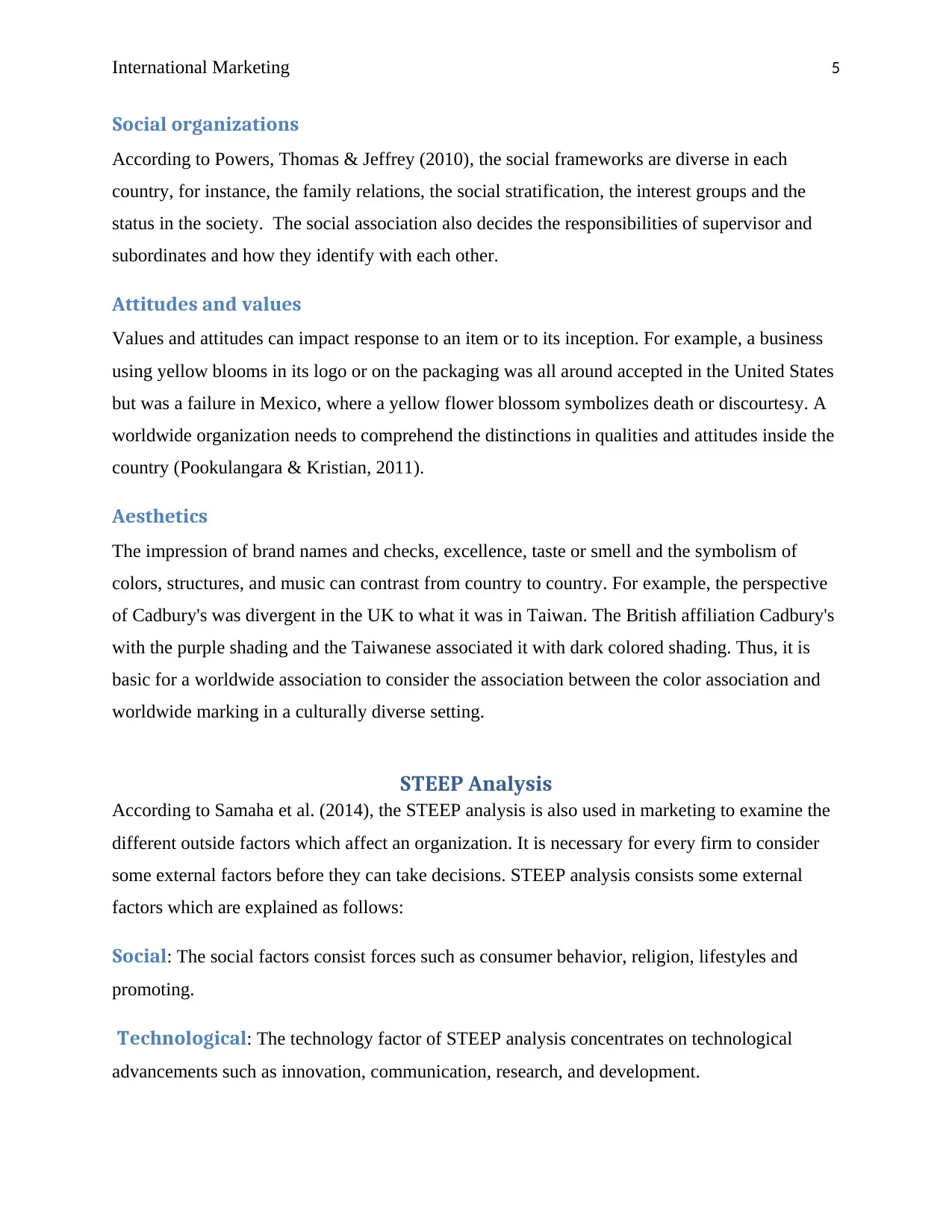
International Marketing 5
Social organizations
According to Powers, Thomas & Jeffrey (2010), the social frameworks are diverse in each
country, for instance, the family relations, the social stratification, the interest groups and the
status in the society. The social association also decides the responsibilities of supervisor and
subordinates and how they identify with each other.
Attitudes and values
Values and attitudes can impact response to an item or to its inception. For example, a business
using yellow blooms in its logo or on the packaging was all around accepted in the United States
but was a failure in Mexico, where a yellow flower blossom symbolizes death or discourtesy. A
worldwide organization needs to comprehend the distinctions in qualities and attitudes inside the
country (Pookulangara & Kristian, 2011).
Aesthetics
The impression of brand names and checks, excellence, taste or smell and the symbolism of
colors, structures, and music can contrast from country to country. For example, the perspective
of Cadbury's was divergent in the UK to what it was in Taiwan. The British affiliation Cadbury's
with the purple shading and the Taiwanese associated it with dark colored shading. Thus, it is
basic for a worldwide association to consider the association between the color association and
worldwide marking in a culturally diverse setting.
STEEP Analysis
According to Samaha et al. (2014), the STEEP analysis is also used in marketing to examine the
different outside factors which affect an organization. It is necessary for every firm to consider
some external factors before they can take decisions. STEEP analysis consists some external
factors which are explained as follows:
Social: The social factors consist forces such as consumer behavior, religion, lifestyles and
promoting.
Technological: The technology factor of STEEP analysis concentrates on technological
advancements such as innovation, communication, research, and development.
Social organizations
According to Powers, Thomas & Jeffrey (2010), the social frameworks are diverse in each
country, for instance, the family relations, the social stratification, the interest groups and the
status in the society. The social association also decides the responsibilities of supervisor and
subordinates and how they identify with each other.
Attitudes and values
Values and attitudes can impact response to an item or to its inception. For example, a business
using yellow blooms in its logo or on the packaging was all around accepted in the United States
but was a failure in Mexico, where a yellow flower blossom symbolizes death or discourtesy. A
worldwide organization needs to comprehend the distinctions in qualities and attitudes inside the
country (Pookulangara & Kristian, 2011).
Aesthetics
The impression of brand names and checks, excellence, taste or smell and the symbolism of
colors, structures, and music can contrast from country to country. For example, the perspective
of Cadbury's was divergent in the UK to what it was in Taiwan. The British affiliation Cadbury's
with the purple shading and the Taiwanese associated it with dark colored shading. Thus, it is
basic for a worldwide association to consider the association between the color association and
worldwide marking in a culturally diverse setting.
STEEP Analysis
According to Samaha et al. (2014), the STEEP analysis is also used in marketing to examine the
different outside factors which affect an organization. It is necessary for every firm to consider
some external factors before they can take decisions. STEEP analysis consists some external
factors which are explained as follows:
Social: The social factors consist forces such as consumer behavior, religion, lifestyles and
promoting.
Technological: The technology factor of STEEP analysis concentrates on technological
advancements such as innovation, communication, research, and development.
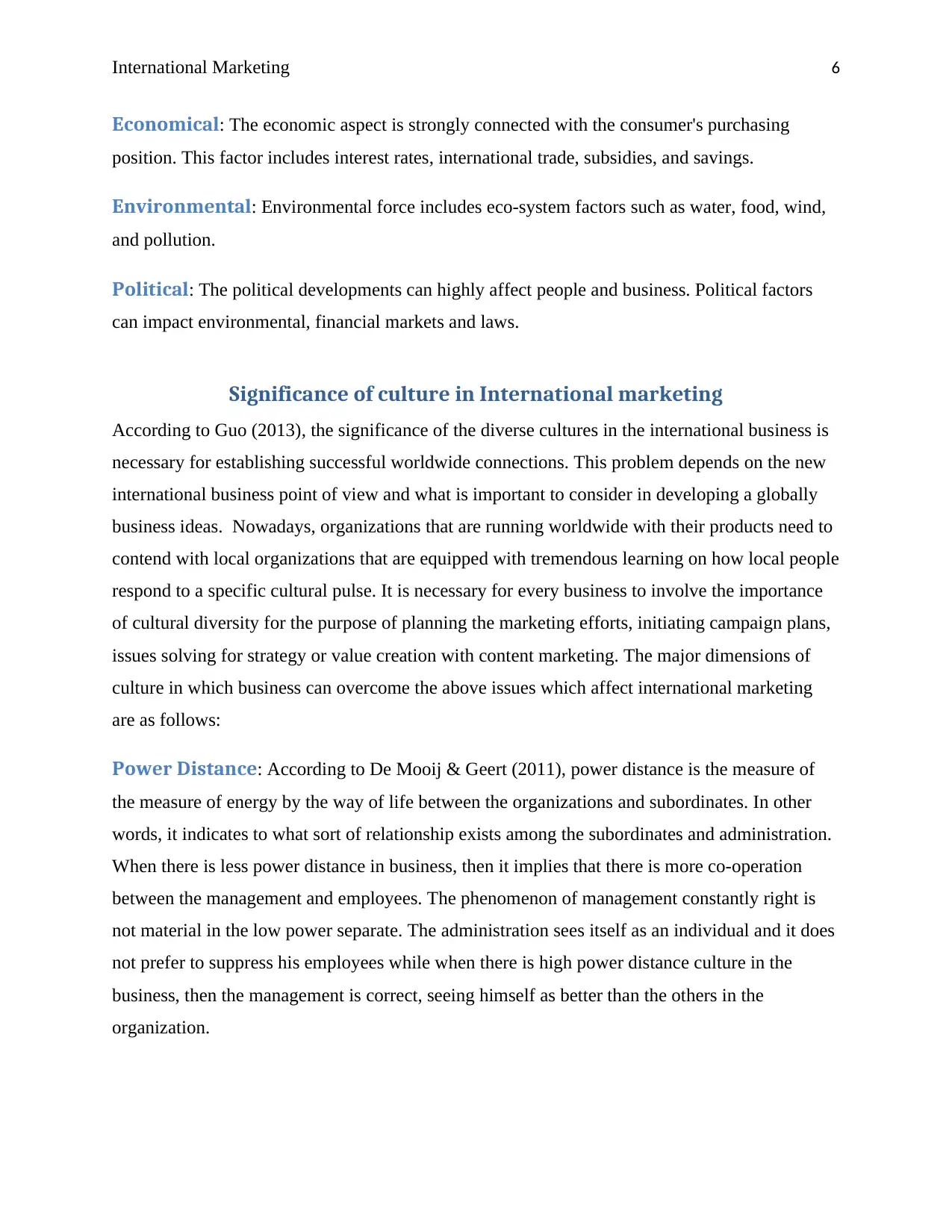
International Marketing 6
Economical: The economic aspect is strongly connected with the consumer's purchasing
position. This factor includes interest rates, international trade, subsidies, and savings.
Environmental: Environmental force includes eco-system factors such as water, food, wind,
and pollution.
Political: The political developments can highly affect people and business. Political factors
can impact environmental, financial markets and laws.
Significance of culture in International marketing
According to Guo (2013), the significance of the diverse cultures in the international business is
necessary for establishing successful worldwide connections. This problem depends on the new
international business point of view and what is important to consider in developing a globally
business ideas. Nowadays, organizations that are running worldwide with their products need to
contend with local organizations that are equipped with tremendous learning on how local people
respond to a specific cultural pulse. It is necessary for every business to involve the importance
of cultural diversity for the purpose of planning the marketing efforts, initiating campaign plans,
issues solving for strategy or value creation with content marketing. The major dimensions of
culture in which business can overcome the above issues which affect international marketing
are as follows:
Power Distance: According to De Mooij & Geert (2011), power distance is the measure of
the measure of energy by the way of life between the organizations and subordinates. In other
words, it indicates to what sort of relationship exists among the subordinates and administration.
When there is less power distance in business, then it implies that there is more co-operation
between the management and employees. The phenomenon of management constantly right is
not material in the low power separate. The administration sees itself as an individual and it does
not prefer to suppress his employees while when there is high power distance culture in the
business, then the management is correct, seeing himself as better than the others in the
organization.
Economical: The economic aspect is strongly connected with the consumer's purchasing
position. This factor includes interest rates, international trade, subsidies, and savings.
Environmental: Environmental force includes eco-system factors such as water, food, wind,
and pollution.
Political: The political developments can highly affect people and business. Political factors
can impact environmental, financial markets and laws.
Significance of culture in International marketing
According to Guo (2013), the significance of the diverse cultures in the international business is
necessary for establishing successful worldwide connections. This problem depends on the new
international business point of view and what is important to consider in developing a globally
business ideas. Nowadays, organizations that are running worldwide with their products need to
contend with local organizations that are equipped with tremendous learning on how local people
respond to a specific cultural pulse. It is necessary for every business to involve the importance
of cultural diversity for the purpose of planning the marketing efforts, initiating campaign plans,
issues solving for strategy or value creation with content marketing. The major dimensions of
culture in which business can overcome the above issues which affect international marketing
are as follows:
Power Distance: According to De Mooij & Geert (2011), power distance is the measure of
the measure of energy by the way of life between the organizations and subordinates. In other
words, it indicates to what sort of relationship exists among the subordinates and administration.
When there is less power distance in business, then it implies that there is more co-operation
between the management and employees. The phenomenon of management constantly right is
not material in the low power separate. The administration sees itself as an individual and it does
not prefer to suppress his employees while when there is high power distance culture in the
business, then the management is correct, seeing himself as better than the others in the
organization.
⊘ This is a preview!⊘
Do you want full access?
Subscribe today to unlock all pages.

Trusted by 1+ million students worldwide

International Marketing 7
Individualism: The plan of individualism depends on the logic that one is the proprietor of his
or her life and he or she has a right to live it as per their wants and needs and he or she has the
choice to look for the qualities they consider good for himself or herself.
Masculinity v/s Femininity: Masculinity refers to a male prevailing nation, society or
culture where gentility alludes to a nation, society or culture where the privileges of ladies are
equivalent to men. For example, in western countries, the rights for men and women are equal in
the workplace (Akaka et al. 2013).
Uncertainty Avoidance: Uncertainty avoidance refers that individual ignore from taking
part in the activities about which they don't affirm that they will advantage them. They are glad
to get occupied with exercises of which they are sure they will benefit from and they have no
protection towards risk.
Uncertainty Avoidance expresses that people refrain from participating in the activities about
which they do not have a clue about that they will benefit them. They are happy to get connected
with activities of which they are sure they will benefit by and they have no protection towards
the peril. Pakistan, India and the Arab countries have such a kind of culture while on other hand
countries that have low defenselessness shirking, they have more protection from risk.
Individualism: The plan of individualism depends on the logic that one is the proprietor of his
or her life and he or she has a right to live it as per their wants and needs and he or she has the
choice to look for the qualities they consider good for himself or herself.
Masculinity v/s Femininity: Masculinity refers to a male prevailing nation, society or
culture where gentility alludes to a nation, society or culture where the privileges of ladies are
equivalent to men. For example, in western countries, the rights for men and women are equal in
the workplace (Akaka et al. 2013).
Uncertainty Avoidance: Uncertainty avoidance refers that individual ignore from taking
part in the activities about which they don't affirm that they will advantage them. They are glad
to get occupied with exercises of which they are sure they will benefit from and they have no
protection towards risk.
Uncertainty Avoidance expresses that people refrain from participating in the activities about
which they do not have a clue about that they will benefit them. They are happy to get connected
with activities of which they are sure they will benefit by and they have no protection towards
the peril. Pakistan, India and the Arab countries have such a kind of culture while on other hand
countries that have low defenselessness shirking, they have more protection from risk.
Paraphrase This Document
Need a fresh take? Get an instant paraphrase of this document with our AI Paraphraser
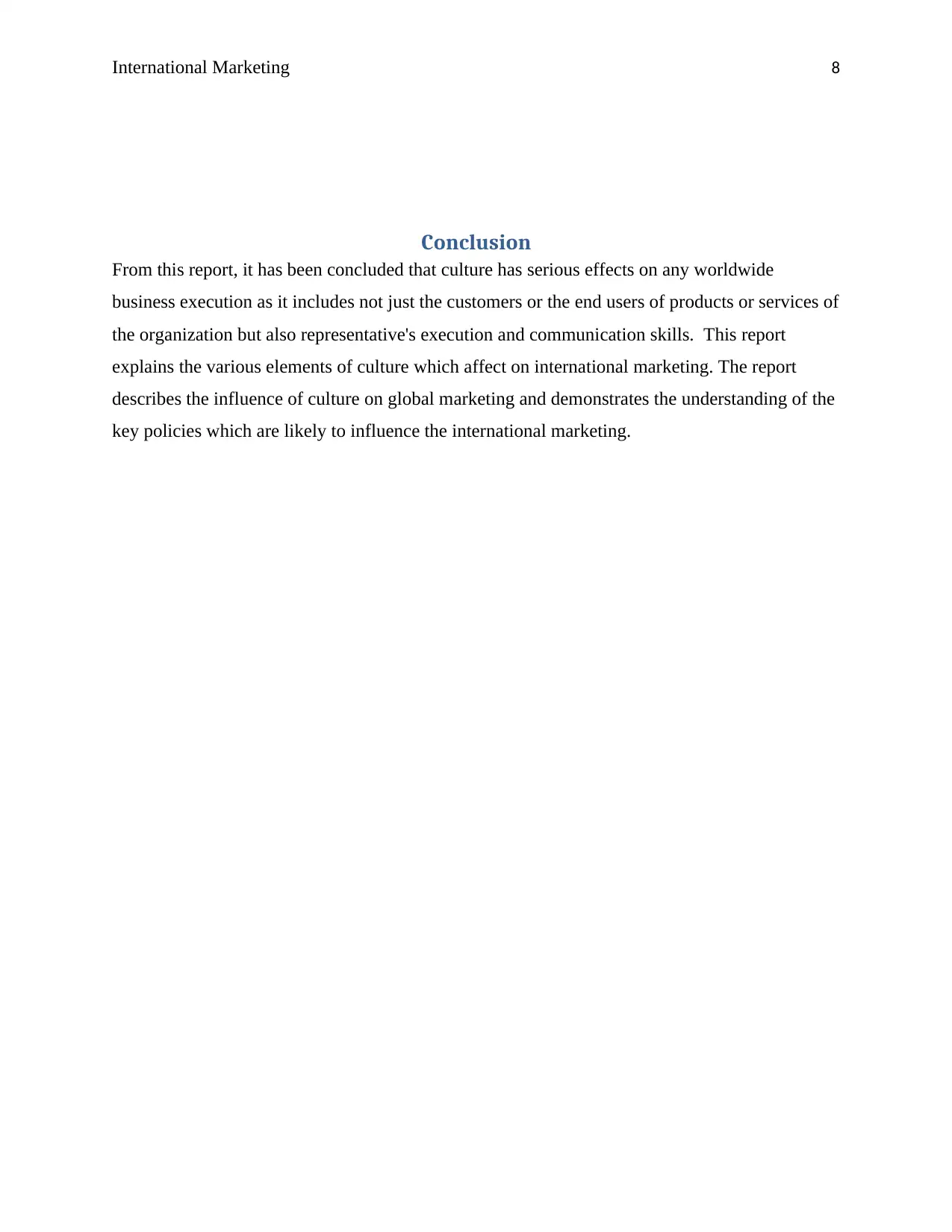
International Marketing 8
Conclusion
From this report, it has been concluded that culture has serious effects on any worldwide
business execution as it includes not just the customers or the end users of products or services of
the organization but also representative's execution and communication skills. This report
explains the various elements of culture which affect on international marketing. The report
describes the influence of culture on global marketing and demonstrates the understanding of the
key policies which are likely to influence the international marketing.
Conclusion
From this report, it has been concluded that culture has serious effects on any worldwide
business execution as it includes not just the customers or the end users of products or services of
the organization but also representative's execution and communication skills. This report
explains the various elements of culture which affect on international marketing. The report
describes the influence of culture on global marketing and demonstrates the understanding of the
key policies which are likely to influence the international marketing.

International Marketing 9
References
Akaka, Melissa Archpru, Stephen L. Vargo, & Robert F. Lusch. "The complexity of context: A
service ecosystems approach for international marketing." Journal of Marketing Research 21,
no. 4 (2013): 1-20.
De Mooij, Marieke, & Geert Hofstede. "Cross-cultural consumer behavior: A review of research
findings." Journal of International Consumer Marketing 23, no. 3-4 (2011): 181-192.
Guo, Xiaoling. "Living in a global world: Influence of consumer global orientation on attitudes
toward global brands from developed versus emerging countries." Journal of International
Marketing 21, no. 1 (2013): 1-22.
Jiang, Jing, & Ran Wei. "Influences of culture and market convergence on the international
advertising strategies of multinational corporations in North America, Europe and
Asia." International Marketing Review 29, no. 6 (2012): 597-622.
Ladhari, Riadh, Frank Pons, Grégory Bressolles, & Michel Zins. "Culture and personal values:
How they influence perceived service quality." Journal of Business Research 64, no. 9 (2011):
951-957.
Pookulangara, Sanjukta, & Kristian Koesler. "Cultural influence on consumers' usage of social
networks and its' impact on online purchase intentions." Journal of Retailing and Consumer
Services18, no. 4 (2011): 348-354.
Powers, Thomas L, & Jeffrey J. Loyka. "Adaptation of marketing mix elements in international
markets." Journal of global marketing 23, no. 1 (2010): 65-79.
Samaha, Stephen A., Joshua T. Beck, & Robert W. Palmatier. "The role of culture in
international relationship marketing." Journal of Marketing 78, no. 5 (2014): 78-98.
References
Akaka, Melissa Archpru, Stephen L. Vargo, & Robert F. Lusch. "The complexity of context: A
service ecosystems approach for international marketing." Journal of Marketing Research 21,
no. 4 (2013): 1-20.
De Mooij, Marieke, & Geert Hofstede. "Cross-cultural consumer behavior: A review of research
findings." Journal of International Consumer Marketing 23, no. 3-4 (2011): 181-192.
Guo, Xiaoling. "Living in a global world: Influence of consumer global orientation on attitudes
toward global brands from developed versus emerging countries." Journal of International
Marketing 21, no. 1 (2013): 1-22.
Jiang, Jing, & Ran Wei. "Influences of culture and market convergence on the international
advertising strategies of multinational corporations in North America, Europe and
Asia." International Marketing Review 29, no. 6 (2012): 597-622.
Ladhari, Riadh, Frank Pons, Grégory Bressolles, & Michel Zins. "Culture and personal values:
How they influence perceived service quality." Journal of Business Research 64, no. 9 (2011):
951-957.
Pookulangara, Sanjukta, & Kristian Koesler. "Cultural influence on consumers' usage of social
networks and its' impact on online purchase intentions." Journal of Retailing and Consumer
Services18, no. 4 (2011): 348-354.
Powers, Thomas L, & Jeffrey J. Loyka. "Adaptation of marketing mix elements in international
markets." Journal of global marketing 23, no. 1 (2010): 65-79.
Samaha, Stephen A., Joshua T. Beck, & Robert W. Palmatier. "The role of culture in
international relationship marketing." Journal of Marketing 78, no. 5 (2014): 78-98.
⊘ This is a preview!⊘
Do you want full access?
Subscribe today to unlock all pages.

Trusted by 1+ million students worldwide
1 out of 9
Related Documents
Your All-in-One AI-Powered Toolkit for Academic Success.
+13062052269
info@desklib.com
Available 24*7 on WhatsApp / Email
![[object Object]](/_next/static/media/star-bottom.7253800d.svg)
Unlock your academic potential
Copyright © 2020–2025 A2Z Services. All Rights Reserved. Developed and managed by ZUCOL.





